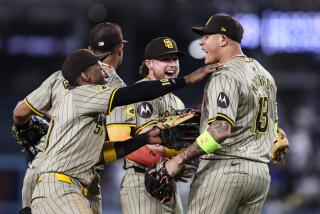Angels Lose Game in Bizarre Ending
- Share via
CHICAGO — The Angels lost to the White Sox on Wednesday night after a bitterly contested ruling by the umpires that kept the ninth inning alive and gave Chicago a chance to score the winning run -- which it promptly did.
It was tied 1-1 in the ninth. There were two outs and two strikes on the batter, Chicago’s A.J. Pierzynski.
Then came the fatal pitch. It was low.
Angel catcher Josh Paul reached and caught it -- or did he trap it against the dirt? Home plate umpire Doug Eddings waved his right hand and then clenched it, two gestures, he said later, that indicated a swinging strike. But he never called the batter out.
Paul, thinking the inning was over, rolled the ball to the mound and the Angels started to leave the field. But Pierzynski, realizing he hadn’t been called out, sprinted to first -- and was called safe.
Now the Angels erupted in protest. But the umpires refused to call Pierzynski out, and three pitches later, Joe Crede doubled home pinch-runner Pablo Ozuna from second base and the White Sox won, 2-1, to even the best-of-seven American League championship series at one game apiece.
Eddings later said that Paul had trapped Kelvim Escobar’s pitch, a split-fingered fastball that became a swinging strike three to Pierzynski.
In that case, the out had to be recorded by tagging Pierzynski or throwing to first base. Paul instead underhanded the ball toward the mound. Pierzynski, sensing Eddings’ hesitance, dashed to first after taking a couple of steps toward his own dugout.
“I didn’t hear him call me out, so I thought -- I thought for sure the ball hit the ground,” said Pierzynski, a catcher himself. “I watched the replay 50 times and I still don’t know.”
Angel Manager Mike Scioscia argued that Paul caught the ball before it hit the ground, that Eddings called Pierzynski out, “and somewhere along the line, because the guy ran to first base, he altered the call. When an umpire calls a guy out and you’re the catcher, and I’ve caught my share of them, he’s out. He didn’t call ‘swing,’ he rang him up with his fist and said, ‘You’re out.’ ”
Eddings said he called no such thing. He said he believed the ball was live, even after the two motions he made with his right arm.
Scioscia’s on-field debate centered on Paul making the catch, and also on Eddings’ gestures, which many interpreted as calling the third out. It was that call that caused the Angels to abandon their positions and Paul to relinquish the ball.
“My interpretation is that’s my ‘strike three’ mechanic when it’s a swinging strike,” Eddings said. “If you watch, that’s what I do the whole entire game.”
While many Angels viewed the replay and concluded that Paul had wrapped the webbing of his mitt beneath the ball, and Pierzynski, for one, concluded there was no conclusion to be had, Eddings, his crew, and umpire supervisor Rich Rieker agreed that Paul had trapped it.
Using what Rieker called “some technology,” the six-man umpiring crew viewed the replay and determined the ball had actually hit the dirt.
“We saw a couple different angles,” Eddings said, “and if you watch it, the ball changes direction.”
It is possible the ball ricocheted from the end of Paul’s mitt into the pocket, but replays appeared to show a clean catch.
“I caught the ball,” Paul said. “It was strike three. He was out.... It’s not my fault. I take no responsibility for that whatsoever.”
After his initial argument, Scioscia left the field, then returned after learning of the replay.
He appealed the call to third-base umpire Ed Rapuano, who would have had the best view of the pitch to the left-handed Pierzynski. After a short consultation with Rapuano, Eddings pointed to the ground, meaning they agreed, the ball had been trapped.
As the Angels fumed in their clubhouse, Eddings sat beside Rieker and crew chief Jerry Crawford in an interview room across the hall.
“At this point,” Rieker said, “I would say at best it’s inconclusive. I wouldn’t totally agree that the ball was caught, but there was a change in direction there that we saw and the replay is available to us.”
Typically, when a catcher believes a strike-three pitch may or may not have bounced before he catches it, he instinctively will tag the runner.
“That’s why I was pretty shocked at what took place, and that was what I was kind of talking to Scioscia about,” Eddings said. “Josh Paul, like you said, especially if you guys have seen the replay, it was questionable.”
Added Rieker: “And since Doug did not say that the batter was out, play continues, and that ball is alive.”
Eddings said of his third-strike routine -- the sweep of his right hand, then the clenched fist -- “It’s never been an issue until now.”
*
(BEGIN TEXT OF INFOBOX)
Strike three
--
Baseball’s rules on a third strike:
Rule 6.05 (b)
A batter is out when a third strike is legally caught by the catcher; “Legally caught” means in the catcher’s glove before the ball touches the ground....
Rule 6.09 (b)
The batter becomes a runner when the third strike called by the umpire is not caught, providing (1) first base is unoccupied, or (2) first base is occupied with two out; When a batter becomes a base runner on a third strike not caught by the catcher and starts for the dugout, or his position, and then realizes his situation and attempts then to reach first base, he is not out unless he or first base is tagged before he reaches first base....
Source: MLB.com
More to Read
Go beyond the scoreboard
Get the latest on L.A.'s teams in the daily Sports Report newsletter.
You may occasionally receive promotional content from the Los Angeles Times.






